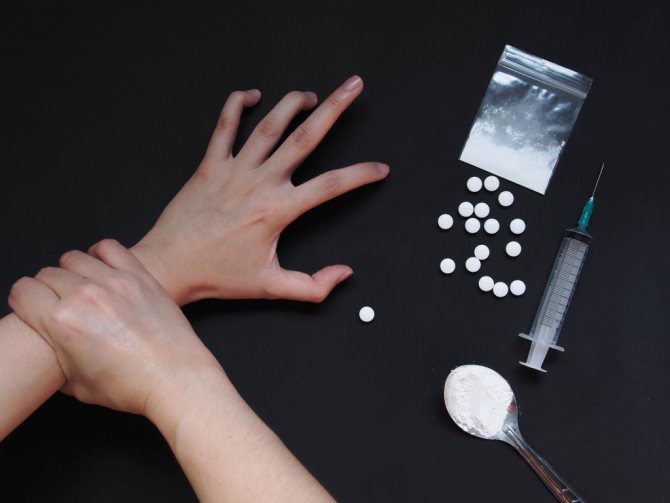Amphetamine psychosis is a pathological condition caused by regular use of amphetamine or other central nervous system stimulant. In all respects, the disorder resembles paranoid schizophrenia with its characteristic lability, delusions, auditory and visual hallucinations. In the absence or untimely initiation of therapy, symptoms increase, the patient becomes aggressive, loses self-control, and the risk of developing early dementia increases.
Effect of the drug
This is where you should start. Why do people get hooked on amphetamine in the first place? Because its use causes many seemingly pleasant effects. Here's what happens:
- Your mood improves quickly.
- Self-confidence appears.
- Motor and speech activity increases significantly.
- Drowsiness is eliminated instantly.
- Impressive performance appears.
However, the consequences of taking it are serious. When withdrawal begins, not a trace remains of the effect.
Arrhythmia, tremors of the limbs, anxiety, panic attack, disturbed sleep - these are the most harmless consequences. Memories of experienced sensations force a person to take amphetamine again. Only the second time the body will need a larger dose. After all, tolerance to amphetamine develops very quickly.

Briefly about the condition
As a rule, amphetamine psychosis develops as a result of long-term use of this substance. However, in some cases it also occurs with a single dose of an excessively large dose of a psychostimulant.
What exactly is this condition? This is a mental disorder, the cause of which lies in brain intoxication. A person’s consciousness and all perception of the reality around him are simply disturbed.
Amphetamine psychosis can last two to three weeks. There are cases when this condition dragged on for several years. Its danger is that it can continue even after completely quitting the drug.
But, as mentioned above, even consuming this substance once can harm the body. To be more precise, 140 mg of the drug can provoke acute psychosis. It lasts 1-3 days, sometimes it drags on for a week.

Parkinson's (Alzheimer's) disease from amphetamine use
Parkinson's disease is primarily a chronic neurological disease. And since amphetamine constantly stimulates the nervous system, when taking a dose, the human body produces hormones such as norepinephrine and adrenaline in large quantities.
This is a great stress for the body, because this action is accompanied by pressure surges, increased blood sugar, and constriction of blood vessels. This leads to the fact that the nervous system is depleted, and together with a genetic predisposition to Alzheimer's disease, taking amphetamine can play a decisive role in a person's fate.
Amphetamine affects dopamine receptors, in simple words - those receptors that are involved in the processes of thinking, memory, learning, and fine motor coordination.
Risk factors
Amphetamine psychosis much more often affects people with physical illnesses, adolescents with an unstable psyche, and also those individuals who uncontrollably use various drugs.
But that is not all. In people addicted to amphetamine, delusional psychosis develops much faster and earlier than in cocaine addicts.
They seem to suffer from paranoid schizophrenia accompanied by persecutory delusions. Sometimes it is even impossible to make a differential diagnosis based on symptoms, and therefore additional research is required.
Liver cirrhosis as a consequence of amphetamine use
If you think that liver cirrhosis is a disease only of alcoholics, then I hasten to tell you one more fact. Liver cirrhosis, like hepatitis, develops for the same reason, the breakdown of amphetamine into active ephedrine derivatives and inactive substances.
It is also worth noting that hepatitis can cause the development of cirrhosis of the liver. Amphetamine also causes great toxicity in the body, and since the liver is very susceptible to various types of toxins, the accumulation of toxins and thereby liver poisoning leads to the development of liver cirrhosis.
Symptoms
The psychosis that amphetamine addiction usually leads to is accompanied by pronounced symptoms. They can be identified in the following list:
- Delusions (usually paranoid).
- Visual and auditory hallucinations. Olfactory symptoms also occur a little less frequently.
- Sudden mood swings.
- Strong excitability.
- Increased physical activity.
In addition, symptoms of amphetamine psychosis include mania and paranoia. The addict becomes overly sensitive, which causes true hallucinations. Deception of feelings occurs from time to time.

Designation in ICD-10
In the International Classification of Diseases, 10th revision, psychotic disorders associated with stimulant use are designated by the following codes:
- F14.50 Schizophrenia-like disorder due to cocaine use
- F14.51 Predominantly delusional disorder due to cocaine use
- F14.52 Predominantly hallucinatory disorder due to cocaine use
- F14.53 Predominantly polymorphic psychotic disorder due to cocaine use
- F14.54 Cocaine use disorder with predominantly depressive psychotic symptoms
- F14.55 Cocaine use disorder with predominantly manic psychotic symptoms
- F15.50 Schizophrenia-like disorder associated with use of other stimulants (including caffeine)
- F15.51 Predominantly delusional disorder associated with the use of other stimulants (including caffeine)
- F15.52 Predominantly hallucinatory disorder associated with use of other stimulants (including caffeine)
- F15.53 Predominantly polymorphic psychotic disorder associated with the use of other stimulants (including caffeine)
- F15.54 Other stimulant use disorder (including caffeine) with predominantly depressive psychotic symptoms
- F15.55 Other stimulant use disorder (including caffeine) with predominantly manic psychotic symptoms
Manifestations
The psychosis that amphetamine addiction leads to does not go unnoticed. Here's what happens to a person who develops this condition:
- He literally runs from one corner to another, unable to stand still.
- Speech becomes choppy and slurred.
- An aggression appears that the addict cannot control. Because of this, he becomes dangerous not only to others, but also to himself. His further actions become impossible to predict.
- The addict begins to react inappropriately to what others say and do. He may panic.
- Even close people cause irritability and fear in the addict.
- Delusional parasitosis may occur. It is commonly encountered by cocaine addicts. At this moment, it seems to a person that parasites, worms and fleas are running around his body.
In rare cases, amphetamine use results in catatonic agitation, ecstasy, or stupor. Associative thinking stops, the person even begins to hear his thoughts. The symptoms in this condition strongly resemble the acute phase of schizophrenia.

AIDS from using pervintin
Such a common disease as AIDS is well known to many since school. Drug addicts often become infected with this disease after taking amphetamine intravenously (in liquid form it is called pervintin).
There is a very high probability of contracting this disease through drug use. As evidence, I can cite the example that over the past year, ninety-four percent of all AIDS patients were infected through the virus entering the blood as a result of intravenous drug use.
And to be frank, amphetamine (pervintin) is a drug, the effect of which very quickly gets a person “on the needle”, that is, the risk of infection is very high, considering that in the process of developing addiction, the addict stops using different syringes and can take a dose with using a syringe that was infected with HIV.
What after?
Sooner or later the effect of amphetamine wears off. When intoxication begins to gradually “fade away,” the person returns to a normal state. And he doesn’t remember what happened to him before. Psychosis gives way to depression, in which the addict feels overwhelmed, depressed and unhappy.
Then the withdrawal begins. The feeling of “omnipotence” experienced by a person under the influence of a drug is replaced by lethargy. To return to the previous level, the addict takes another dose, this time larger.
An increase in the amount of amphetamine consumed is fraught with severe headaches, blurred vision and excessive cardiac stress. Often amphetamine addicts develop arrhythmia and heart failure. However, the worst consequence is hemorrhagic stroke and coma.
It is also worth mentioning that the drug removes calcium from the body, and this is fraught with problems with bones and teeth.
It is very difficult to survive “withdrawal”. Only time will help. You need to drink a lot of water, it is better to induce vomiting. Painkillers may help a little. Since withdrawal is accompanied by increased aggression, it is important that the person remains calm. Corvalol, motherwort or valerian can help here.

Toxic encephalopathy from amphetamine or pervintin
As stated earlier, amphetamines bring a bad gift to our body - a very large amount of toxins. These same toxins affect all organs, penetrating the blood and subsequently reaching the holy of holies - the brain.
Symptoms such as trembling, cold sweat, memory loss, slurred speech, insomnia, and headaches appear. If the encephalopathy is not severe, then you can get away with simply “hanging” like bad Winda...
And, if the toxic damage is great, then this can lead to coma, and subsequently to death.
Treatment of amphetamine psychosis
Few people manage to get rid of addiction on their own. The rest require rehabilitation in a hospital setting.
Treatment begins with complete cessation of amphetamine and subsequent detoxification. It gives the greatest effect if less than an hour has passed since the drug was taken. Unfortunately, there is no antidote, but a good result is demonstrated by gastric lavage and the use of some kind of sorbent (activated carbon, for example).
Also, for the purpose of emergency drug removal, urine can be acidified using ammonium chloride. But this method increases the risk of developing acute kidney failure. So the decision on the appropriateness of this method is made by the doctor, focusing on the results of the analysis.
Until the end of detoxification, symptomatic treatment is carried out, the purpose of which is to maintain normal heart rate, blood pressure and temperature. Therapy is completed when it is possible to completely remove amphetamine from the body and restore vital functions.

Mental recovery
It was said above how to remove amphetamine from the body. A few words should be said directly about the restoration of the psyche.
Hallucinations and paranoid delusions are eliminated with the help of phenothiazines. As a rule, intramuscular administration of haloperidol or chlorpromazine is prescribed.
These drugs can quickly eliminate the signs of psychosis, but they can also provoke side effects, which include extrapyramidal reaction and postural hypotension.
Also, one of the main goals of therapy is to eliminate depression. It may continue for several weeks. In this case, the patient is prescribed antidepressants.
Of course, in addition to medications, psychotherapeutic treatment is prescribed. One of its key components is cognitive behavioral therapy. It is indicated for schizophrenia, however, it is also effective for psychosis provoked by taking amphetamine. Its goal is to develop the patient’s self-control skills and restore the relationships between thinking, behavior and emotions.

Treatment results
The best outcome that can be achieved at the end of therapy is complete relief from amphetamine psychosis. The following factors indicate recovery:
- Stimulated cognitive activity.
- Improved memory and concentration.
- Extended social circle of the patient.
- Solutions found for problems identified during treatment.
- Attenuated post-psychotic depression.
As a result of rehabilitation, the former drug addict successfully fits into everyday life, realizes his importance, and restores social and everyday skills.
It is very important that loved ones support him during the therapy period. Rehabilitation will be successful only if the person remains in a calm environment, where there is no place for stressful situations, conflicts and breakdowns. Because even a slight overstrain can lead to a return to amphetamine.










